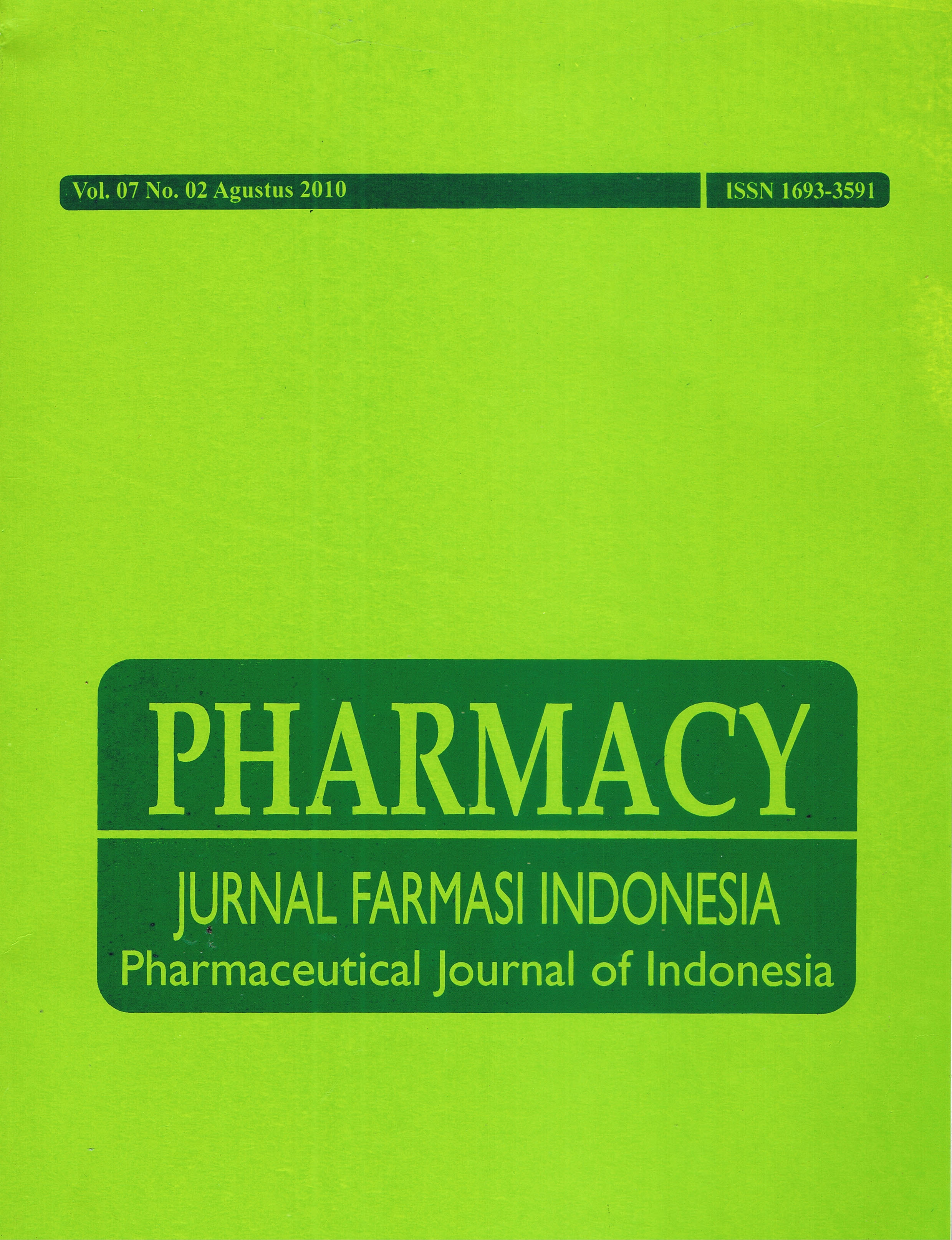PENETAPAN KADAR TANIN DAUN RAMBUTAN (Nephelium lappaceum.L ) SECARA SPEKTROFOTOMETRI ULTRAVIOLET VISIBEL
DOI:
https://doi.org/10.30595/pji.v7i1.552Abstract
ABSTRAK Telah dilakukan penelitian penetapan kadar tanin pada daun rambutan (Nephelium lappaceum) dengan metode spektrofotometri ultraviolet visibel. Penetapan kadar dilakukan untuk mengetahui jumlah kadar yang terkandung dalam daun rambutan. Metode yang digunakan untuk penyarian simplisia adalah metode maserasi. Ekstrak yang sudah didapat kemudian diencerkan, ditambahkan reagen Folin Denis dan Natrium Karbonat anhidrat, setelah itu dibaca pada panjang gelombang maksimum dan pada saat operating time tercapai. Reaksi pembentukan yang terjadi adalah reduksi oksidasi dimana tanin sebagai reduktor dan folin Denis sebagai oksidator. Hasil oksidasi akan membentuk warna biru yang dapat dibaca panjang gelombang maksimal. Hasil perhitungan rata-rata kadar pada daun rambutan muda adalah 6.25% dengan SD sebesar 0.08327 dan KV sebesar 1.3%. Kadar rata-rata daun rambutan tua adalah 6.62%, dengan SD sebesar 0.02309%. dan KV 0.35%. Hasil uji t menunjukkan bahwa kadar tanin daun rambutan dengan variasi umur mempunyai perbedaan kadar yang signifikan. Kata Kunci: Tanin, Daun Rambutan, Spektrofotometri Ultraviolet visibel ABSTRACT A research on determination of tannin in rambutan leaf (Nephelium lappaceum) by the ultraviolet visible spectrophotometry method has been done. Determination was done to investigate the tannin content in rambutan leaf. Extraction method used in this research was maceration method. Extract was added by reagent Folin Denis and Natrium Carbonate anhydrate and subsequently read at particular maximum wavelength and operating time. Forming reaction that happened was oxidize reduction where tannin as reductor and folin Denis as oxidator. Result of oxidation formed blue color which could be read maximal wavelength. Result of the mean of tannin content in young rambutan leaf was 6.25 % with SD equal to 0.08327 and CV equal to 1.3 %. The mean of tannin content old rambutan leaf, SD, and CV was 6.62%, 0.02309% and CV 0.35%, respectively. T-test showed that there were differences of tannin content in young and old rambutan leaves. Keywords: Tannin, Rambutan Leaf, Ultraviolet visible spectrophotometry.References
Afrianto, E. 2008. Pengaawasan Mutu Bahan/ Produk Pangan jilid II Untuk Sekolah Menengah Kejuruan. Jakarta: Direktorat Pembinaan SM
Arikunto, S. 2002. Prosedur Penelitian Suatu Pendekatan Praktek edisi Revisi V. Jakarta: PT. Asdi Mahasatya P: 328,333
Backer & Bakhuizen Van Den Brink, 1963. Flora Of Java (Spermatophytes only) Vol II. The Netherlands: N.V.P Noordhoff-groningen P: 138
Cunnif, P., 1996. Official Method Of Analysis Of AOAC International sixteeth edition Vol II, Published by AOAC international Suite 500, 481 North freederick Avenue Gaithersburg: Maryland 20877-2417 USA
Dalimartha, S. 2007.Atlas Tumbuhan Obat Indonesia, Jakarta
Depkes RI, 1979.Farmakope Indonesia ed III. Jakarta : Departemen Kesehatan RI P:59
Depkes RI, 1985. Cara Pembuatan Simplisia. Jakarta: Direktorat Jendral Pengawasan Obat Dan Makanan P: 10,14
Depkes R1, 1986. Sediaan Galenik. Jakarta: Departemen Kesehatan RI P: 2, 10-13
Harborne, S.B, 1987. Metode Fitokimia. Bandung: ITB P: 21, 71,102-104
Robinson, T. 1995. Kandungan Organik Tumbuhan Tinggi. Bandung: ITB P:71-¬73.
Tjokronegoro, A., dan Baziad, A., 1992. Etik Penelitian Obat Tradisional. Fakultas Kedokteran Universitas Indonesia, Jakarta P:27
Downloads
Published
How to Cite
Issue
Section
License
Authors who publish with this journal agree to the following terms:
- Authors retain copyright and grant the journal right of first publication with the work simultaneously licensed under a Creative Commons Attribution 4.0 International License that allows others to share the work with an acknowledgement of the work's authorship and initial publication in this journal.
- Authors are able to enter into separate, additional contractual arrangements for the non-exclusive distribution of the journal's published version of the work (e.g., post it to an institutional repository or publish it in a book), with an acknowledgement of its initial publication in this journal.
- Authors are permitted and encouraged to post their work online (e.g., in institutional repositories or on their website) prior to and during the submission process, as it can lead to productive exchanges, as well as earlier and greater citation of published work (See The Effect of Open Access).






